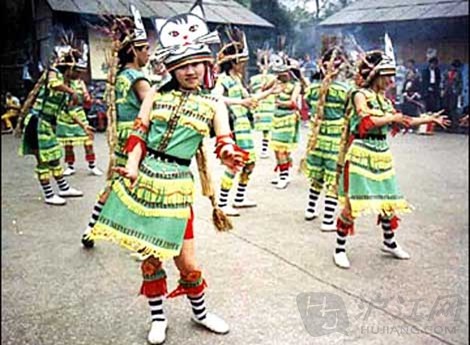Introduction
The earliest Han Chinese language spoken in Guangdong, Guangxi and North Vietnam was called proto-Western Yue Chinese. It was based on Old Chinese spoken during the Qin and Han dynasty. The Nanyue kingdom was contemporary with the Qin and Han periods.This was the Yue Chinese language spoken during the Nanyue kingdom and not Cantonese language as it is commonly believed.
Proto-Tai language
The natives of Guangxi are the Zhuang people who are part of Tai-Kadai people. They spoke proto-Tai in ancient times. |
| Zhuang fire cat dance in Wuzhou, Guangxi |
Proto-Western Yue Chinese
In 214 BC (Qin dynasty), a strategic canal called Ling Canal (靈渠) was dug to join Xiang River, a tributary of Yangtze River, in Hunan province and Gui river (桂江) of Pearl River Basin in Guangxi province.
This provided the only river route from Central China to southernmost China due to the formidable physical barrier formed by the Nanling 南嶺 mountain.
The Qin period (214 BC-205 BC) and the successive Nanyue 南越 Kingdom (204 BC-111 BC) represent the first wave of Han Chinese to Lingnan 嶺南. Lingnan is a collective term for Guangdong, Guangxi and North Vietnam.
In 106 BC, Han dynasty established Guangxin 廣信 as the provincial capital of Lingnan after conquering Nanyue kingdom a few years earlier. This period was the second wave of Han Chinese migration into southernmost China.
Guangxin is situated around the region of modern-day Wuzhou 梧州 (see map above) and the city served as the cultural and linguistic center for proto-Western Yue Chinese before the center was moved to Guangzhou in 226 AD after the end of the Han dynasty.
This ancestral Chinese language became the lingua franca for Han Chinese in Lingnan until the end of Tang dynasty.
This provided the only river route from Central China to southernmost China due to the formidable physical barrier formed by the Nanling 南嶺 mountain.
The Qin period (214 BC-205 BC) and the successive Nanyue 南越 Kingdom (204 BC-111 BC) represent the first wave of Han Chinese to Lingnan 嶺南. Lingnan is a collective term for Guangdong, Guangxi and North Vietnam.
 |
| Main river route (red color) and Wuzhou |
In 106 BC, Han dynasty established Guangxin 廣信 as the provincial capital of Lingnan after conquering Nanyue kingdom a few years earlier. This period was the second wave of Han Chinese migration into southernmost China.
Guangxin is situated around the region of modern-day Wuzhou 梧州 (see map above) and the city served as the cultural and linguistic center for proto-Western Yue Chinese before the center was moved to Guangzhou in 226 AD after the end of the Han dynasty.
This ancestral Chinese language became the lingua franca for Han Chinese in Lingnan until the end of Tang dynasty.
 |
| Han dynasty conquest of Nanyue kingdom |
Gou-Lou language
One of its descendant languages developed into Gou-Lou 勾漏 language with its prestige dialect as Yulin dialect 玉林話. The mutual intelligibility with Guangfu language is low and is considered a different Yue language.The Yulin dialect of the Gou-Lou language is demonstrated in the video below.
The distribution of Gou-Lou speakers is to the north-western border of Guangfu speakers with its center around Wuzhou (except Wuzhou itself which is flooded with Guangfu speakers).
 |
| Distribution of various Yue Chinese speakers |
The Han Chinese lived with the natives and a certain percentage intermarried with the female Zhuang speaking people of Guangxi. Further research is needed to determine the extent and details of proto-Tai language influence on proto-Western Yue Chinese language.
Western Yue language subfamily
Western Yue languages have voiced initial consonants such as 'b' and 'd' which existed until the late Middle Chinese but which were lost in Cantonese language.
Chinese
|
Cantonese
|
Gou-Lou
|
補
|
pou
|
bu
|
蕉
|
ciu
|
diu
|
Furthermore, the initial consonants follow Old Chinese phonology of 't' (aspirated and non-aspirated) which has changed to 'c' (aspirated and non-aspirated) in Middle Chinese language phonology.
Chinese
|
Cantonese
|
Gou-Lou
|
秋
|
chau
|
thau
|
前
|
chin
|
tin
|
寺
|
ci
|
ti
|
There are several uncategorised Yue Chinese languages such as Gao-Yang, Wu-Hua and Qin-Lian. Thus, further research is needed to identify which other Yue languages belong to this subfamily.
Conclusion
Western Yue languages are not well-known outside Guangxi province but they are the descendants of the earliest Yue Chinese language spoken in Lingnan.
Guangfu speakers have all but replaced the original Yue Chinese speakers spoken in Pearl River delta in Guangdong and Wuzhou city in Guangxi due to the huge wave of Tang dynasty migrants.
Gou-Lou speakers were shielded from this huge wave of migrants due to its relatively remote area from the Pearl River delta. This meant that they were able to preserve more elements from the Old Chinese language spoken during the Qin and Han dynasty.
Guangfu language has become so predominant in Guangdong province so much so that people mistakenly think that it was the original Yue Chinese language.
Origin of Cantonese language
http://eastasiaorigin.blogspot.com/2017/10/origin-of-cantonese-language.html
Origin of Vietnamese language
http://eastasiaorigin.blogspot.com/2017/07/origin-of-vietnamese-language.html
Origin of Han Chinese
http://eastasiaorigin.blogspot.com/2017/06/ethnic-origin-of-han-chinese.html
Guangfu speakers have all but replaced the original Yue Chinese speakers spoken in Pearl River delta in Guangdong and Wuzhou city in Guangxi due to the huge wave of Tang dynasty migrants.
Gou-Lou speakers were shielded from this huge wave of migrants due to its relatively remote area from the Pearl River delta. This meant that they were able to preserve more elements from the Old Chinese language spoken during the Qin and Han dynasty.
Guangfu language has become so predominant in Guangdong province so much so that people mistakenly think that it was the original Yue Chinese language.
Related links
http://eastasiaorigin.blogspot.com/2017/10/origin-of-cantonese-language.html
Origin of Vietnamese language
http://eastasiaorigin.blogspot.com/2017/07/origin-of-vietnamese-language.html
Origin of Han Chinese
http://eastasiaorigin.blogspot.com/2017/06/ethnic-origin-of-han-chinese.html
Sources
Sources
- http://cul.china.com.cn/minsu/2011-04/12/content_4128137.htm
- Diversity of Sinitic languages by Hilary Chappell
- http://hk.crntt.com/crn-webapp/cbspub/secDetail.jsp?bookid=48441&secid=48654
Last updated: 10 June 2021
Copyright © eastasiaorigin.blogspot 2017. All rights reserved.
Comments
Post a Comment